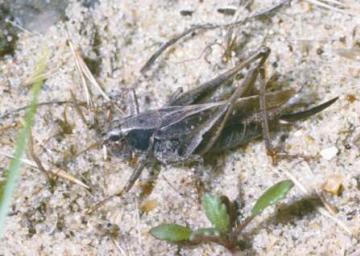Species Account for Platycleis albopunctata
Platycleis albopunctata (Goeze, 1778)
Grey Bush Cricket
Orthoptera group: Tettigoniidae

Reproduction for study and non-profit use permitted, all other rights reserved.
Taxonomic group: grasshoppers, crickets & allies (Orthoptera group) - County data
View time series maps for Platycleis albopunctata
member log-on for taxon report
Status: NS
Essex RDB: Listed
Threat: Essex Endangered
Images
upload a new image
Grey Bush-Cricket on Orthoptera Recording Scheme website
Essex Red Data List comment
Restricted to south facing coasts almost exclusively to the furthest south of the country. In Essex three old 1km records covering TM01 and TM11 at East Mersea (pre-1896) and St Osyth (pre-1940). The area has been searched without success. Details in Wake
Species text
The rediscovery of Grey Bush-cricket Platycleis albopunctata at Colne Point in 2004 was an exciting event. The species occurs mainly on the south coasts of England and Wales. Marshall & Haes (1988) show a map with both South and North Essex marked with pre-1961 records and state that there are no post-1960 records north of the Thames Estuary, but reference Lucas (1920) that one or two colonies existed on the Essex coast until early in the 20th century. Interestingly, subsequently to the discovery at Colne Point a colony was discovered in 1996 at Orford Ness, in Suffolk (Sutton 2004). There are three old ten km records at East Mersea (pre-1896) and St Osyth (pre-1940) (Gardiner & Harvey 2004). A number of people have searched for the species since without success, and it was considered probably extinct in the county, and a possibility for re-introduction in the future. The Grey Bush-cricket is a medium sized bush-cricket, usually greyish brown, though the dorsal surface may be chestnut brown or even green. The most definite distinguishing feature from fully winged examples of Roesel's Bush-cricket Metrioptera roeselii is the median keel on the posterior part of the pronotum in the female, but the typical coloration is unlikely to cause confusion with that species. Marshall & Haes (op. cit.) state that the species appears to be restricted to the coast where it occurs in coarse grass and herbage on sand dunes, shingle beaches or on south-facing cliffs with good vegetation. It seems that the amount of suitable habitat at Colne Point is very limited. Nevertheless there is little doubt that the species has always been present at the site and has simply remained undetected until 2004. The rarity of the species away from the south coast of England and its continuing occurrence north of the Thames warrant further study. It is recommended that the species is subject to specific autecological work to investigate its needs and requirements at the reserve. References
Habitats
Recorded substrate and hydrology for locations with Platycleis albopunctata
Why not join the Club, register and add a new species page
Interpretation of distribution maps




















